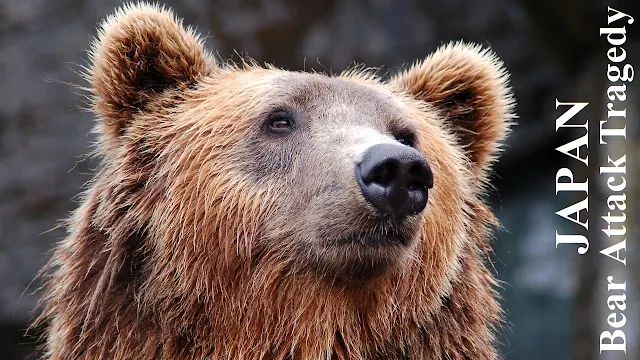- The Bear Attack recent tragedy in Japan!
- What factors are contributing to the increase in bear attacks in Japan?
The Bear Attack recent tragedy in Japan!
In a heart-wrenching incident, a college student's life came to a tragic end in the picturesque landscapes of northern Japan, leading authorities to suspect a bear attack. This distressing discovery adds to a series of bear-related incidents that have struck Japan this year, raising concerns among the local population. Let's delve into the details.
The unfortunate incident unfolded last week on Mount Daisengen, a majestic peak nestled in the lower reaches of Hokkaido, Japan's northernmost island. The lifeless body was identified as that of Kanato Yanaike, a 22-year-old college student from Hakodate, who had embarked on a climbing expedition but had mysteriously disappeared earlier in the week.
A chilling detail emerged as Yanaike's body was found near a deceased brown bear, evoking suspicions of a bear attack. Just two days prior to this grim discovery, another group of men had survived a brown bear encounter in the same vicinity, indicating a potentially troubling pattern.
The cause of Yanaike's demise was determined to be hemorrhagic shock, but with the presence of a brown bear's carcass nearby, authorities couldn't rule out the possibility of a bear attack.
Prior to the incident, Yanaike had shared his climbing plans with an acquaintance, setting out for Mount Daisengen on October 29. His car was later located near a trailhead on the mountain. It was at this site that his lifeless body was discovered, eerily echoing the location of the earlier bear attack on October 31, when three men had faced a perilous encounter with a brown bear. Fortunately, they had managed to repel the animal, though two of them sustained injuries in the process.
Now, authorities are diligently probing whether this might be the latest incident involving the same brown bear responsible for multiple attacks in the area. The Hokkaido Research Organization has announced plans to examine the stomach contents of the bear carcass, providing critical evidence in the ongoing investigation.
Bear attacks have been a growing concern in Japan this year, with a staggering 109 people injured in such incidents between April and September 2023. Most of these attacks occurred in the northern part of Japan's main island, Honshu. Tragically, two of the victims lost their lives, including one in Hokkaido.
This alarming trend has persisted throughout the year. In May, a fisherman fell victim to a suspected bear attack near a lake in the northern part of Hokkaido, which is not far from Mount Daisengen. The discovery of a human head in the area led authorities to believe the man had been mauled and decapitated by a brown bear.
In August, hunters in the remote northern region of Japan had to take down a notorious brown bear, nicknamed "Ninja," after it attacked over 66 cows. This animal's aggressive behavior had created a major threat to local livelihoods.
Early in October, local authorities and media outlets reported that three bears were euthanized after they found their way into a tatami mat factory in the northern part of Japan. These bears had sought refuge inside the factory for nearly a day, causing concern and prompting action.
Local governments in Japan have speculated that the bear population's rapid growth, surpassing available food resources, might be contributing to the increase in bear attacks. Reports suggest that a bountiful year for beech nuts and acorns in 2022 may have led to this surge in bear populations. However, this year's scarcity in nut production has driven bears to venture outside their usual habitats in search of sustenance, occasionally bringing them into contact with human communities as they prepare for hibernation.
What factors are contributing to the increase in bear attacks in Japan?
The increase in bear attacks in Japan can be attributed to a combination of factors. One major factor is the rapid growth in the bear population, which has outpaced the available food resources for these animals. In 2022, there was an abundant supply of beech nuts and acorns, leading to a surge in the bear population. However, this year's scarcity in nut production has forced bears to venture outside their usual habitats in search of food, bringing them into contact with human communities, especially as they prepare for hibernation.
Additionally, the encroachment of human activities into bear territory has led to increased interactions and conflicts. This includes activities like hiking, camping, and hunting in bear-inhabited areas.
The recent incidents in Hokkaido, where a college student lost his life, and where hunters had to euthanize a problematic brown bear, highlight the need for a better understanding of the delicate balance between humans and wildlife in Japan's wilderness. Local authorities and organizations are actively investigating these incidents and taking steps to mitigate the risks associated with bear encounters.
In summary, the increase in bear attacks in Japan is a result of a growing bear population, food scarcity in their natural habitat, and increased human activities in bear-inhabited areas, leading to more frequent interactions and conflicts.
Ecosystem Challenges: Delving into the ecological factors behind the bear population dynamics.
"Balancing nature's equation: bears, habitat, and humans."
The tragic loss of Kanato Yanaike serves as a poignant reminder of the importance of understanding and addressing the delicate balance between humans and wildlife in the beautiful yet unforgiving wilderness of Japan. Authorities will continue their investigations into this alarming trend of bear attacks, with the hope of preventing further tragedies in the future.


